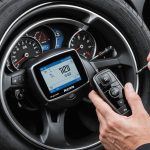Introduction to Adaptive Cruise Control in Classic UK Cars
The marvel of adaptive cruise control is transforming how classic car enthusiasts embrace their beloved vehicles. This modern technology adjusts the car’s speed in tune with traffic flow, enhancing safety and fuel efficiency. Classic car aficionados often face the challenge of enjoying their timeless machines without compromising on modern comforts.
Integrating such modernization into classic vehicles not only elevates the driving experience but also preserves the authenticity of the vintage charm while incorporating cutting-edge advancements. This blend of old and new allows drivers to maintain a connection with the past while navigating today’s roads with updated technology.
This might interest you : Ultimate guide to revamping your classic uk car”s fuel system: key steps for an effective upgrade
Historically, cruise control began as a basic speed maintenance tool in automobiles, emerging prominently in the 1950s. Early systems were purely mechanical, reflecting the technology of their time. However, as technology advanced, so did cruise control, evolving into today’s adaptive systems that leverage sensors and computers to adjust in real-time to changing road conditions.
Modernization in classic cars offers more than just convenience. It opens a new realm for vehicle personalization, combining nostalgia with practicality. For classic car owners, modifying their vehicles with adaptive cruise control can be a joyful experience, simultaneously enhancing safety and preserving the timeless allure these vehicles hold.
Also to discover : Ultimate tips for custom audio system installation in uk cars: a comprehensive guide
Necessary Tools and Parts for Installation
Installing an adaptive cruise control system in your classic car requires precision and the right toolkit. It’s essential to gather the necessary tools and parts to ensure a smooth and effective installation process.
Essential Tools
To begin, you’ll need a comprehensive set of tools:
- Socket set: Crucial for loosening and tightening various parts.
- Screwdrivers: Both flat-head and Phillips for different screw types.
- Wire strippers and crimpers: Vital for safe and effective wiring.
- Multimeter: Measures electrical currents, ensuring safe installations.
Recommended Parts and Kits
Selecting the right adaptive cruise control installation kit is paramount. Opt for a kit compatible with your classic car’s specifics. High-quality kits often include:
- Sensors and cameras: For detecting and adjusting to traffic conditions.
- Control modules: Vital for system regulation and car integration.
- Wiring harness: Connects all components efficiently.
Sourcing Quality Components
Securing top-notch parts elevates performance and reliability. Reputable auto parts retailers or specialised vintage car restoration shops often stock quality components. Online automotive platforms also provide access to reviews and ratings, aiding informed decisions. This preparation is crucial, setting the stage for a successful installation, ensuring both functionality and preservation of your classic car’s unique charm.
Step-By-Step Installation Process
Installing an adaptive cruise control system isn’t just about owning the right tools and parts—it’s about following a precise and comprehensive plan. The installation process demands attention to detail and a patient hand.
Preparing Your Classic Car for Installation
Before diving into the installation process, it’s crucial to prepare your classic car. Begin by disconnecting the battery to ensure safety. Clear out any clutter from the interior that might obstruct the workspace. A clean, organized environment significantly eases the task.
Installing the Adaptive Cruise Control Hardware
Mount the necessary hardware as specified by the retrofit cruise control guide. This usually involves positioning sensors and control modules accurately, maintaining unobstructed views for the sensors. Follow the specific instructions for bracket installation, as improper setup can affect performance.
Wiring and Electrical Considerations
When tackling wiring, refer to the vehicle’s wiring diagram to ensure correct connections. Use wire strippers and crimpers for secure connections, ensuring no loose ends. It’s imperative to test each connection with a multimeter, confirming appropriate current flow. Prioritize safety precautions, wearing protective gear and working systematically to avoid errors.
Engage in troubleshooting if issues arise. If challenges persist, consider seeking professional assistance to guarantee successful installation and optimal functionality of your adaptive cruise control system.
Troubleshooting Common Installation Challenges
Amidst installing an adaptive cruise control system in a classic car, several common issues may arise, potentially hindering progress. Let’s delve into tackling these challenges efficiently.
Identifying Frequent Problems
One prevalent issue is improper sensor calibration, which can lead to inaccurate speed adjustments. Additionally, misaligned brackets may obstruct sensor views. These problems often stem from inconsistent installation techniques.
Solutions and Tips for Overcoming Challenges
To rectify sensor calibration, ensure that all sensors are mounted per manufacturer specifications. It’s vital to adjust their placement carefully, checking for clear lines of sight. For bracket alignment, verify each piece rests firmly, ensuring stability and effective operation. Regularly monitor these setups to confirm ongoing accuracy.
When to Seek Professional Help
While many are enthusiastic about a DIY approach, some tech mishaps necessitate professional intervention. Complex wiring errors, repeated sensor failures, or integrated system malfunctions should prompt a consultation with automotive experts. This ensures that the adaptive cruise control system operates as intended, safeguarding your vehicle’s newly acquired functionality.
Approaching these hurdles systematically not only promises successful installation but also preserves the timeless appeal of your classic car while integrating modern conveniences.
Ensuring Safety and Compliance After Installation
Once the adaptive cruise control system is installed in your classic car, ensuring its safety and compliance is crucial for a seamless driving experience. Begin by performing rigorous system testing. This step verifies that the system responds correctly to various traffic scenarios. Test the car in different environments, assessing its ability to adjust speed and maintain safe distances on highways and city roads.
Understanding vehicle regulations is essential. Modified cars often need to comply with specific legal standards. Check how your modifications align with local vehicle codes to avoid fines or penalties. Consulting regulatory guides can mitigate compliance issues and ensure peace of mind.
Focus on safety features during upgrades. Ensure sensors and electronic components adapt to classic car structures without compromising the vehicle’s original integrity. Modern safety elements, like collision warning systems, enhance the driving experience.
Stay informed about best practices by engaging with automotive experts. They provide insights on maintaining your cruise control system, ensuring it functions efficiently and safely over time. Keeping abreast of safety measures ensures the longevity and reliability of your new vehicle enhancements. These steps not only protect the vehicle’s authenticity but also elevate its integration into today’s road systems.
Expert Tips and Recommendations
For those venturing into car modification, especially with intricate systems like adaptive cruise control, expert advice proves invaluable. Automotive professionals suggest focusing on thorough planning and precision. Success begins with understanding your vehicle’s specifications and limitations. Consulting experienced mechanics before launching a modification project can prevent costly errors and ensure compatibility with your classic car.
To maintain your adaptive cruise control system, routine inspections are advised. Regularly check sensors and wiring for wear and tear, and recalibrate if needed to ensure optimal performance. Professionals also stress the importance of software updates, which improve system functionality and address potential bugs.
For those eager to expand their knowledge, numerous resources assist in honing your skills. Online forums like car enthusiast communities offer practical insights and peer support, fostering a learning environment for both novices and veterans. You might consider subscribing to automotive magazines, which often feature in-depth articles on technology integration.
Engage with workshops or webinars dedicated to vehicle modernization. These sessions provide hands-on experience and direct interaction with experts. Staying informed about the latest trends and techniques not only enhances your personal projects but also helps preserve the historic charm of your cherished classic cars.
Additional Resources and References
For classic car enthusiasts delving into the world of modernization, access to the right resources and guides can significantly ease the transition. Understanding the intricacies of adaptive cruise control requires more than just a basic grasp; it involves continuous learning and engagement with expert communities.
Online Forums and Communities
Joining car enthusiast forums is invaluable. Platforms specifically targeting vintage car owners offer insightful advice on integrating modern technologies. Experienced community members share their personal projects and troubleshooting tips, providing a wealth of knowledge and camaraderie.
Recommended Reading
To deepen your understanding, consider reading specialized articles and books on automotive technology integration. Publications focusing on the intersection of classic car heritage and modern advancements can offer practical insights and historical context.
Installation Manuals and Guides
Access to comprehensive installation manuals is crucial. Whether you purchase your kit online or from a vintage car restoration shop, ensure it comes with a detailed guide. These manuals guide you through each step, ensuring precision and accuracy in your installation process.
These resources equip you with the knowledge to navigate modernisation projects confidently, preserving your classic car’s charm while integrating new technologies effectively.









